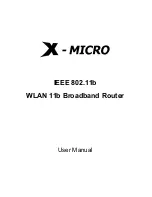
Optimizing Traffic Flow with Port Controls, Port Trunking, and Port-Based Priority
Port Trunking
Trunks.
The ports on both sides of an LACP trunk must be configured for
the same speed and for full-duplex (FDx). The 802.3ad LACP standard speci
fies a full-duplex (FDx) requirement for LACP trunking.
A port configured as LACP passive and not assigned to a port trunk can be
configured to half-duplex (HDx). However, in any of the following cases, a
port cannot be reconfigured to an HDx setting:
■
If a port is set to LACP Active, you cannot configure it to HDx.
■
If a port is already a member of a static or dynamic LACP trunk, you cannot
configure it to HDx.
■
If a port is already set to HDx, the switch does not allow you to configure
it for a static or dynamic LACP trunk.
Dynamic/Static LACP Interoperation:
A port configured for dynamic
LACP can properly interoperate with a port configured for static (Trk
X
) LACP,
but any ports configured as standby LACP links will be ignored.
Trunk Group Operation Using the “Trunk” Option
This method creates a trunk group that operates independently of specific
trunking protocols and does not use a protocol exchange with the device on
the other end of the trunk. With this choice, the switch simply uses the SA/DA
method of distributing outbound traffic across the trunked ports without
regard for how that traffic is handled by the device at the other end of the
trunked links. Similarly, the switch handles incoming traffic from the trunked
links as if it were from a trunked source.
Use the Trunk option when you are trying to establish a trunk group between
the switch and another device, but the other device’s trunking operation fails
to interoperate properly with LACP or FEC trunking configured on the switch
itself.
Trunk Operation Using the “FEC” Option
This is the most flexible method for distributing traffic over trunked links
when connecting to devices that use the FEC (Fast EtherChannel) technology.
FEC trunks offer the following benefits:
■
Provide trunked connectivity to a FEC-compliant server, switch, or router.
■
Enable quick convergence to remaining links when a failure is detected
on a trunked port link.
■
Depending on the capabilities of the device on the other end of the trunk,
negotiate the forwarding mechanism on the trunk to the non-protocol
option.
10-31
Содержание ProCurve 6108
Страница 2: ......
Страница 18: ... This page is intentionally blank xvi ...
Страница 50: ...Using the Menu Interface Where To Go From Here This page is intentionally unused 3 16 ...
Страница 110: ...Switch Memory and Configuration Using Primary and Secondary Flash Image Options This page is intentionally unused 6 20 ...
Страница 300: ...Port Based Virtual LANs VLANs and GVRP GVRP This page is intentionally unused 12 48 ...
Страница 432: ...IP Routing Features Configuring DHCP Relay This page is intentionally unused 16 24 ...
Страница 522: ...Troubleshooting Restoring a Flash Image This page is intentionally unused C 44 ...
Страница 528: ...MAC Address Management Determining MAC Addresses This page is intentionally unused D 6 ...
Страница 532: ...Daylight Savings Time on HP ProCurve Switches This page is intentionally unused E 4 ...
Страница 546: ... This page is intentionally unused 14 Index ...
















































